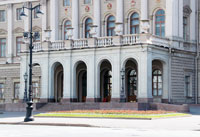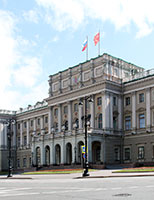

Andrei Stackenschneider (named spelled variously)Brumfield says of this architect: "Although the post neoclassical era witnessed the displacement of the imperial design in architecture by an eclecticism directed by other economic and social forces, the reign of Nicholas also initiated the last major phase of palace construction in Petersburg. The architect who directed the undertaking, Andrei Shtakenshneider, lacked the genius of the great imperial architects of the preceding century, but he skillfully exploited the possibilities of eclecticism to produce a blend of the neo-Renaissance and neo-baroque" (406). Two of his palaces in St. Petersburg are on this web site: this, the Mariinsky Palace and the Nikolaevsky Palace (Nicholas Palace).In the late 1830s Stackenschneider's buildings for royal patrons began in St. Petersburg with his first project being this palace for the grand duchess Maria Nikolaevich, the oldest daughter of Nicholas I. It has a grand location across from St. Isaacs Cathedral although today the plaza in front of it is a huge parking lot. | ||
The first of Stackenschneider's great palaces in St. PetersburgThis classical (some call it neo-Renaissance) building has a typical formula. The elongated facade terminates in projecting flanking pavilions, complete with pedimented porticos, while the emphatic front has a portico with an attic rather than a pediment. Compared to earlier palace architecture, this building seems austere and undecorated. Hamilton calls this architect's work "dull" although he admits it has "massive dignity" (390). In later years this building was used for various governmental functions. |
 | |
| Like many Renaissance palaces (they are smaller though), the ground floor is rusticated. The gigantic order of engaged Corinthian columns and pilasters extends through two stories, the piano nobile and the second floor. Windows are pedimented on the piano nobile and balusters add some grace to this massive palace. And beautiful arched windows are used in the central and two side bays, echoing the arcaded entrance porch. | ||
 |
 |
 |
 Click here to return to index of art historical sites.
Click here to return to index of art historical sites.
 Click here to return to index of artists and architects.
Click here to return to index of artists and architects.
 Click here to return to chronological index.
Click here to return to chronological index.
 Click here to see the home page of Bluffton University.
Click here to see the home page of Bluffton University.

